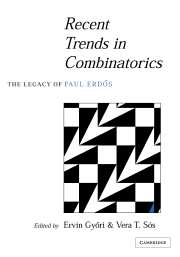Book contents
- Frontmatter
- Contents
- Preface
- Paul Erdős: The Man and the Mathematician (1913–1996)
- 1 A Selection of Problems and Results in Combinatorics
- 2 Combinatorial Nullstellensatz
- 3 Connectedness, Classes and Cycle Index
- 4 A Tutte Polynomial for Coloured Graphs
- 5 Notes on Sum-Free and Related Sets
- 6 Geometrical Bijections in Discrete Lattices
- 7 On Random Intersection Graphs: The Subgraph Problem
- 8 The Blow-up Lemma
- 9 The Homomorphism Structure of Classes of Graphs
- 10 Problem Collection of the DIMANET Mátraháza Workshop, 22–28 October 1995
3 - Connectedness, Classes and Cycle Index
Published online by Cambridge University Press: 03 February 2010
- Frontmatter
- Contents
- Preface
- Paul Erdős: The Man and the Mathematician (1913–1996)
- 1 A Selection of Problems and Results in Combinatorics
- 2 Combinatorial Nullstellensatz
- 3 Connectedness, Classes and Cycle Index
- 4 A Tutte Polynomial for Coloured Graphs
- 5 Notes on Sum-Free and Related Sets
- 6 Geometrical Bijections in Discrete Lattices
- 7 On Random Intersection Graphs: The Subgraph Problem
- 8 The Blow-up Lemma
- 9 The Homomorphism Structure of Classes of Graphs
- 10 Problem Collection of the DIMANET Mátraháza Workshop, 22–28 October 1995
Summary
This paper begins with the observation that half of all graphs containing no induced path of length 3 are disconnected. We generalize this in several directions. First, we give necessary and sufficient conditions (in terms of generating functions) for the probability of connectedness in a suitable class of graphs to tend to a limit strictly between zero and one. Next we give a general framework in which this and related questions can be posed, involving operations on classes of finite structures. Finally, we discuss briefly an algebra associated with such a class of structures, and give a conjecture about its structure.
Introduction
The class of graphs containing no induced path of length 3 has many remarkable properties, stemming from the following well-known observation. Recall that an induced subgraph of a graph consists of a subset S of the vertex set together with all edges contained in S.
Proposition. Let G be a finite graph with more than one vertex, containing no induced path of length 3. Then G is connected if and only if its complement is disconnected.
Proof. It is trivial that the complement of a disconnected graph is connected. Moreover, since P3 is self-complementary, the property of containing no induced P3 is self-complementary. So let G be a minimal counterexample: thus, G and Ḡ are connected but, for any vertex v, either G – v or G – v is disconnected. Choose a vertex v and assume, without loss, that G - v is disconnected. Then v is joined to a vertex in each component of G – v.
- Type
- Chapter
- Information
- Recent Trends in CombinatoricsThe Legacy of Paul Erdős, pp. 31 - 44Publisher: Cambridge University PressPrint publication year: 2001



